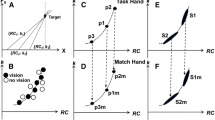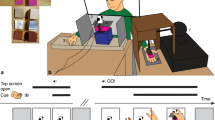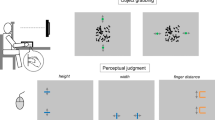Abstract.
The present study examines whether visual information indicating the center of mass (CM) of an object can be used for the appropriate scaling of fingertip forces at each digit during precision grip. In separate experiments subjects lifted an object with various types of visual cues concerning the CM location several times and then rotated and lifted it again to determine whether the visual cues signaling the new location of the CM could be used to appropriately scale the fingertip forces. Specifically, subjects had either no visual cues, visual instructional cues (i.e., an indicator) or visual geometric cues where the longer axis of the object indicated the CM. When no visual cues were provided, subjects were unable to appropriately scale the load forces at each digit following rotation despite their knowledge of the new weight distribution. When visual cues regarding the CM location were provided, the nature of the visual cues determined their effectiveness in retrieval of internal representations underlying the anticipatory scaling of fingertip forces. Specifically, when subjects were provided with visual instructional information, they were unable to appropriately scale the forces. More appropriate scaling of the load forces occurred when the visual cues were ecologically meaningful, i.e., when the shape of the object indicated the CM location. We suggest that visual instructional cues do not have access to the implicit processes underlying dynamic force control, whereas visual geometric cues can be used for the retrieval of the internal representation related to CM for appropriate partitioning of the forces in each digit.





Similar content being viewed by others
References
Boudreau M-J, Brochier T, Paré M, Smith AM (2001) Activity in ventral and dorsal premotor cortex in response to predictable force-pulse perturbations in a precision grip task. J Neurophysiol 86:1067–1078
Burstedt MKO, Birznieks I, Edin BB, Johansson RS (1997a) Control of forces applied by individual fingers engaged in restraint of an active object. J Neurophysiol 78:117–128
Burstedt MKO, Edin BB, Johansson RS (1997b) Coordination of fingertip forces during human manipulation can emerge from independent neural networks controlling each engaged digit. Exp Brain Res 117:67–79
Edin BB, Westling G, Johansson RS (1992) Independent control of human fingertip forces at individual digits during precision lifting. J Physiol Lond 450:547–564
Fadiga L, Fogassi L, Gallese V, Rizzolatti G (2000) Visuomotor neurons: ambiguity of the discharge or 'motor' perception? Int J Psychophysiol 35:165–177
Fagg AH, Arbib MA (1998) Modeling parietal-premotor interactions in primate control of grasping. Neural Netw 11:1277–1303
Flanagan JR, Beltzner MA (2000) Independence of perceptual and sensorimotor predictions in the size-weight illusion. Nat Neurosci 3:737–741
Gentile AM (1998) Implicit and explicit processes during acquisition of functional skills. Scand J Occup Ther 5:7–16
Gentile AM (2000) Skill acquisition: action, movement, and neuromotor processes. In: Carr JH, Shepherd RB (eds) Movement science: foundations for physical therapy in rehabilitation. Aspen Publishers, Gaithersburg, MD, pp 111–187
Gibson JJ (1979) The ecological approach to visual perception. Houghton-Mifflin, Boston
Gordon AM, Forssberg H, Iwasaki N (1994) Formation and lateralization of internal representations underlying motor commands during precision grip. Neuropsychology 32:555–568
Gordon AM, Forssberg H, Johansson RS, Westling G (1991a) Integration of sensory information during the programming of precision grip: comments on the contributions of size cues. Exp Brain Res 85:226–229
Gordon AM, Forssberg H, Johansson RS, Westling G (1991b) Visual size cues in the programming of manipulative forces during precision grip. Exp Brain Res 83:477–482
Gordon AM, Forssberg H, Johansson RS, Eliasson AC, Westling G (1992) Development of human precision grip. III. Integration of visual size cues during the programming of isometric forces. Exp Brain Res 90:399–403
Gordon A, Westling G, Cole KJ, Johansson RS (1993) Memory representations underlying motor commands used during manipulation of common and novel objects. J Neurophysiol 69:1789–1796
Grafton ST, Fadiga L, Arbib MA, Rizzolatti G (1997) Premotor cortex activation during observation and naming of familiar tools. Neuroimage 6:231–236
Grunewald A, Linden JF, Andersen RA (1999) Responses to auditory stimuli in macaque lateral intraparietal area. I. Effects of training. J Neurophysiol 82:330–342
Jenmalm P, Johansson RS (1997) Visual and somatosensory information about object shape control manipulative fingertip forces. J Neurosci 17:4486–4499
Jenmalm P, Dahlstedt S, Johansson RS (2000) Visual and tactile information about object-curvature control fingertip forces and grasp kinematics in human dexterous manipulation. J Neurophysiol 84:2984–2997
Johansson RS, Westling G (1984) Roles of glabrous skin receptors and sensorimotor memory in automatic control of precision grip when lifting rougher or more slippery objects. Exp Brain Res 56:550–564
Johansson RS, Westling G (1988) Coordinated isometric muscle commands adequately and erroneously programmed for the weight during lifting task with precision grip. Exp Brain Res 71:59–71
Johansson RS, Backlin JL, Burstedt MK (1999) Control of grasp stability during pronation and supination movements. Exp Brain Res 128:20–30
Luppino G, Murata A, Govoni P, Matelli M (1999) Largely segregated parietofrontal connections linking rostral intraparietal cortex (areas AIP and VIP) and the ventral premotor cortex (areas F5 and F4). Exp Brain Res 128:181–187
Mon-Williams M, Murray AH (2000) The size of the visual size cue used for programming manipulative forces during precision grip. Exp Brain Res 135:405–410
Murata A, Gallese V, Luppino G, Kaseda M, Sakata H (2000) Selectivity for the shape, size, and orientation of objects for grasping in neurons of monkey parietal area AIP. J Neurophysiol 83:2580–2601
Rizzolatti G, Luppino G (2001) The cortical motor system. Neuron 31:889–901
Rizzolatti G, Fogassi L, Gallese V (2002) Motor and cognitive functions of the ventral premotor cortex. Curr Opin Neurobiol 12:149–154
Salimi A, Hollander I, Frazier W, Gordon AM (2000) Specificity of internal representations underlying grasping. J Neurophysiol 84:2390–2397
Shaw RE, Turvey MT (1981) Coalitions as models for ecosystems: a realist's perspective on perceptual organization. In: Kubovy M, Pomerantz JR (eds) Perceptual organization. Erlbaum, Hillsdale, NJ, pp 343–408
Westling G, Johansson RS (1984) Factors influencing the force control during precision grip. Exp Brain Res 53:277–284
Wing AM, Lederman SJ (1998) Anticipating load torques produced by voluntary movements. J Exp Psychol Hum Percept Perform 24:1571–1581
Acknowledgements.
This project was supported by National Science Foundation Grant 9733679 and the VIDDA foundation (A.M. Gordon). I. Salimi was supported by a fellowship from the Medical Research Council of Canada. R. Reilmann was supported by a fellowship from the German Research Foundation (DFG-RE-1330/1-1). We thank Dr. A.M. Gentile for helpful comments on an earlier version of this manuscript.
Author information
Authors and Affiliations
Corresponding author
Rights and permissions
About this article
Cite this article
Salimi, I., Frazier, W., Reilmann, R. et al. Selective use of visual information signaling objects' center of mass for anticipatory control of manipulative fingertip forces. Exp Brain Res 150, 9–18 (2003). https://doi.org/10.1007/s00221-003-1394-8
Received:
Accepted:
Published:
Issue Date:
DOI: https://doi.org/10.1007/s00221-003-1394-8




